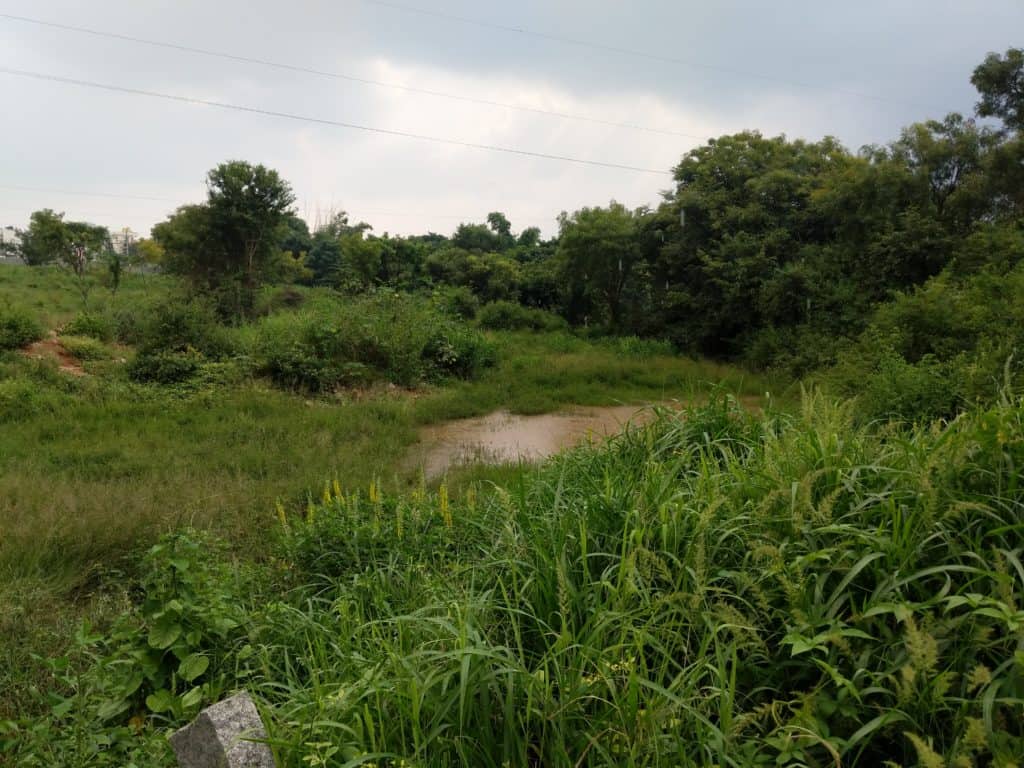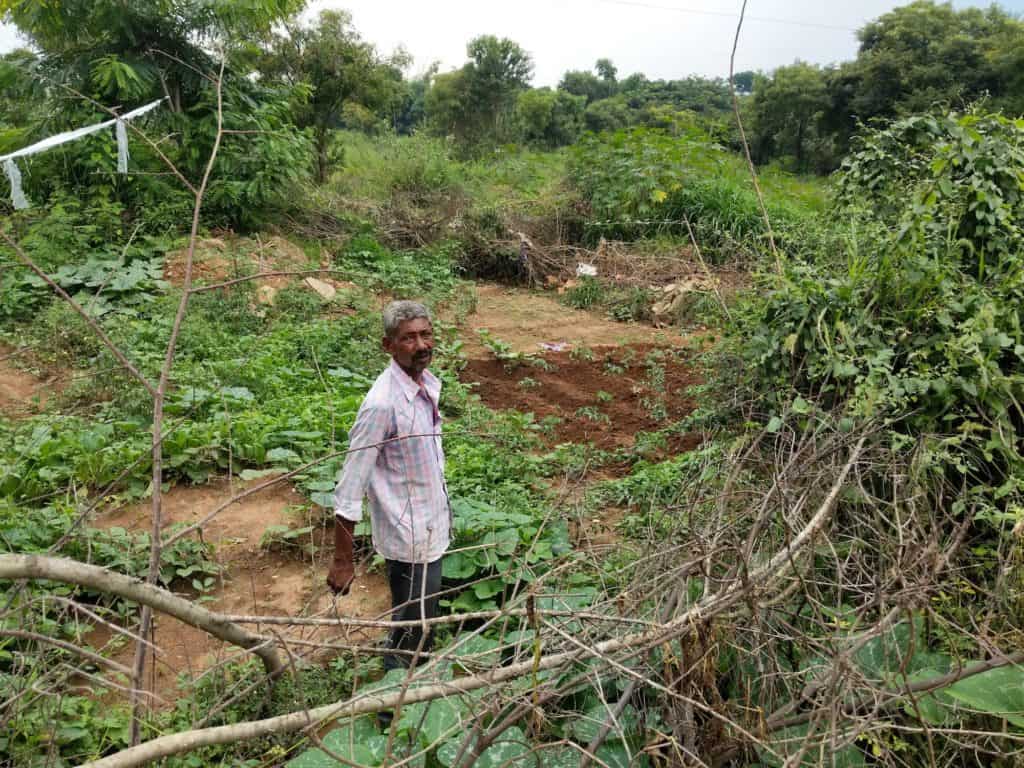Three decades ago, 65-year-old Jayamma had an opportunity to buy a small plot of land at Hosahalli, on the fringes of Bengaluru, where she worked as a tailor in a small garment shop. The area reminded her of her village back in Holenarsipura in Hassan district: a clump of thatched-roof houses, fields of ragi and rice, and small ponds locally called gokattes and kuntes.
Much of the peri-urban life in Hosahalli revolved around the small water bodies: herders brought cattle to the banks, homemakers washed clothes, farmers cultivated lands near its outlets, children used it for their bath or a swim in the summer heat.
Jayamma says, of the katte near her home, “It was surrounded by woods where there were many peacocks, rabbits and smaller animals. During the monsoons, the inlets and outlets from the katte would swell and the fields would be inundated. By winters, we would see thousands of birds.”
Water overflowing from the Harohalli lake comes to a temporarily stop at this katte, and then flows towards Sulikere. Even until 2000, a streak of green marked the stream and the katte in satellite imagery. Now, the katte is a remnant of the wetland that has been subsumed in a sea of concrete.
In 1998, the katte, which was barely three acres, was “rejuvenated” by a nearby residential layout, with a garden, fencing and an overflow weir. But the water body is now filled with sewage. Common moorhens glide past plastic wrappers that float on its placid surface while the croaks of frogs fill the air. The once-thick woods have retreated to the northern side of the fenced water body.
“There are some 5-6 peacocks we can see in the mornings, and lots of snakes. But, no one goes close to the katte anymore. It is filthy,” says Jayamma.

Small water bodies have mostly disappeared
The loss of the city’s lakes is a much-heard anguish of the old Bengalurean. What is less frequently heard about is the disappearance of smaller water bodies, particularly of kattes and kuntes which once pockmarked the city’s landscape in greater numbers than lakes. They often lay between larger lakes as part of the wetland ecosystem.
A 2018 inventory of water bodies of the city by the state-run Environmental Management and Policy Research Institute (EMPRI) revealed that, of the 1,521 water bodies that were found in Bengaluru Metropolitan Area (which roughly covers two-thirds of Bengaluru urban district), just 684 remain.
While 20% of Bengaluru’s lakes have been encroached on and have subsequently disappeared, the largest losses are seen among gokattes (defined as water bodies of between 1 and 3 acre) and kuntes (defined as water bodies less than 1 acre). As per the EMPRI report, 57.5% of gokattes and 75% of kuntes have disappeared. [Find the EMPRI report on this page.]
| Type of water body | Definition | Identified | Existing |
|---|---|---|---|
| Lake | >3 acre | 497 | 395 |
| Gokatte | 1-3 acre | 200 | 85 |
| Kunte | <1 acre | 824 | 204 |
EMPRI’s inventory reveals that gokattes and kuntes have given way to hospitals, schools, graveyards, industries and software parks, apartments and government-approved layouts, authorised and unauthorised buildings, and parks.
The kunte attached to the lake that was drained to build Majestic bus depot is now a manicured park close to the City railway station. Whereas a police station encircled by trees is all that remains of Rajagopal Nagar’s katte.

The EMPRI report was meant to guide the now-defunct Karnataka Lake Conservation and Development Authority in its rejuvenation plans.
But, “no one cares about kattes and kuntes. When we presented our report, officials would tell us that they are focusing on the bigger problem of reviving lakes and cannot look at protecting kattes or kuntes,” says Sreenivas V, research scientist at EMPRI and one of the authors of the report, “However, their loss is as important as the loss of lakes. It is very important to try and save how many ever we can.”
Kattes and kuntes critical for water security, biodiversity
Much like lakes, smaller water bodies have had centuries-long presence in Bengaluru’s undulating terrain. The Wodeyars even tied land grants to individuals to the condition of developing a tank in their lands.
Francis Buchanan, who documented life in Mysore kingdom in the 1800s, differentiated between the water bodies by referring to lakes as being used for irrigation, gokattes as used for cattle, and kuntes as small, square cavities in the ground often for human consumption.
Srinivas says of kuntes and kattes, “These are necessary for water harvesting, and act like natural check dams and feeds for lakes. Almost every lake’s catchment area has a few kattes and kuntes that feeds water to lakes.”
And like lakes, they have an effect on the immediate surroundings that goes beyond water security. As per the EMPRI report, lakes, kattes and kuntes in the city were found to support 36 species of trees, 26 herbs, 77 insect species, 54 avifauna and 12 mammalian species.
Even now, amid the large swathes of concrete between lakes, kattes and kuntes play an important role in sustaining ecosystems. They store rainwater for months after the monsoons, and the spongy soil becomes a magnet for insects, birds, frogs and snakes. Sreenivas says, “They provide a microclimatic sink and a spot for biodiversity to thrive. In Bengaluru, we have seen bees, birds, frogs in these areas. Butterflies can be found mud-puddling.”
S Vishwanath, water conservation expert, says kattes and kuntes host very specific urban biodiversity. “For instance, there are species of grasshoppers that sustain on these small patches. It becomes a symbiotic relationship between the shrubs, fauna and water. They should be protected.”

A 2.13-acre katte at Doddabidarikallu, behind Peenya Industrial Estate, is an example of how these water bodies act as lynchpins of the local ecosystem. The katte falls in an undeveloped 20-acre property owned by Karnataka Handloom Development Corporation which had plans to convert it to a ‘kalagrama’.
Teak, bamboo, melia dubia trees stand out on the banks of the katte. Here, over 25 peacocks, mongooses and numerous varieties of frogs and snakes can be found, says Nagaraj Obanna, a security guard who also cultivates a small patch of tomatoes, leafy vegetables and red gram by the waterbody.
“The katte is formed in a depression, and so all the rainwater from the area flows here. But, it is getting more polluted by the year,” he says.

The area is surrounded by layouts and under-construction apartments. It is a matter of time before this patch of land is developed by the Corporation.
Vishwanath adds that small tanks don’t just facilitate groundwater recharge, but are also a critical defence against floods. But as urban lifestyles become more detached from nature, they are more likely to find use as a car park or garbage dumping ground.
Shunted as wastelands, mosquito-breeding grounds
The rejuvenation of smaller water bodies follows the same principles as rejuvenation of lakes – primarily, buttressing the boundaries and diverting sewage inflow. Bengaluru even has some good templates for protecting small water bodies: the kattes and kuntes within Cubbon Park were recently revived through desilting; Sampangi tank, over which Kanteerava Stadium has been built, has been preserved in one corner as a katte that houses a small bird island.
While lakes have been accorded some sort of protection over the years, this has not been the case with kattes and kuntes.
This is evident even in the Laxman Rau report of 1986, which has become the bulwark for preservation of lakes. The expert committee was formed by the state government to submit proposals for the preservation of existing tanks in Bengaluru. All eight kattes and kuntes looked at by the committee were recommended for conversion into tree parks.
This treatment of smaller water bodies as being “of little use” has continued. EMPRI notes the conversion of existing ponds into sites and amenities in Bangalore Development Authority’s Kempegowda and Vishveshwaraiah layouts.
Many others have been reduced to cesspools, with a popular demand to convert them into manicured parks.
Steep roads from the main road lead towards Karnan Kunte, a fenced-in, brackish pond less than an acre in size in Anjana Nagar, west Bengaluru. The tank was created in 1903, and even now, during the monsoons, it overflows into streams that lead into barren land. While buildings have come up all around the pond, the barren land has remained in dispute. “That’s what is saving the area from floods. The moment the property disputes end, this area will flood,” says Dasharath G, a resident of the area.
A dilapidated stone slab with idols of gods is testament to the religious significance this water body once had in this village-turned-urban layout. Newly-built sanitary lines in the area drain sewage into the pond which is choked with plastic. Despite this, birds are seen frolicking in the waters while hundreds of butterflies feed on the nectar plants on its banks.

Paramesh P, whose house abuts the copse of trees by the kunte, says, “It is a cesspool that makes it impossible to live next to. Each day, we get numerous snakes and frogs entering our homes, while mosquito menace is unending.”
For the past decade, he and other residents have been petitioning authorities to clean out the pond. “We’ve asked for it to be made into a park with a fountain. Or, make it into a playground. They’ve agreed, but no work has happened so far,” he says.
This viewpoint, of water bodies being stench-ridden mosquito breeding grounds or as wasted land, will sustain pressure to fill up kattes and kuntes in the city. And due to the size of these water bodies, this change can take place unnoticed in a matter of months. “It’s death by a thousand cuts,” says Vishwanath.
[This article is part of a series on ‘Bengaluru’s Ecosystems and Biodiversity’. This is a joint project with Mongabay India, and is supported by the Bengaluru Sustainability Forum (BSF).]
Hope Authorities wake up and preserve our city’s beauty. Why dont they work on PPP model and lease it to some sponsors. That way authorities dont have to depend on public money.